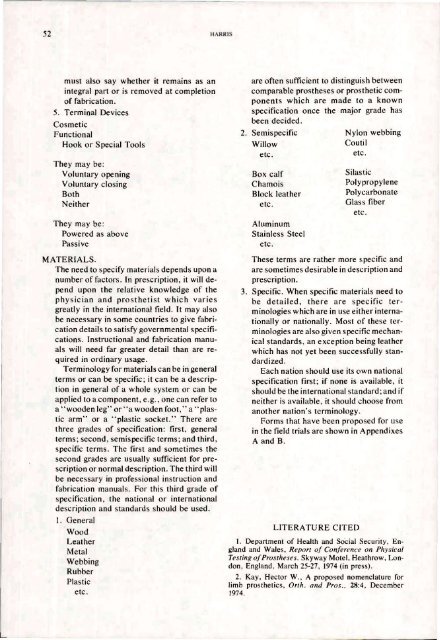Orthotics and Prosthetics
Orthotics and Prosthetics
Orthotics and Prosthetics
You also want an ePaper? Increase the reach of your titles
YUMPU automatically turns print PDFs into web optimized ePapers that Google loves.
must also say whether it remains as an<br />
integral part or is removed at completion<br />
of fabrication.<br />
5. Terminal Devices<br />
Cosmetic<br />
Functional<br />
Hook or Special Tools<br />
They may be:<br />
Voluntary opening<br />
Voluntary closing<br />
Both<br />
Neither<br />
They may be:<br />
Powered as above<br />
Passive<br />
MATERIALS.<br />
The need to specify materials depends upon a<br />
number of factors. In prescription, it will depend<br />
upon the relative knowledge of the<br />
physician <strong>and</strong> prosthetist which varies<br />
greatly in the international field. It may also<br />
be necessary in some countries to give fabrication<br />
details to satisfy governmental specifications.<br />
Instructional <strong>and</strong> fabrication manuals<br />
will need far greater detail than are required<br />
in ordinary usage.<br />
Terminology for materials can be in general<br />
terms or can be specific; it can be a description<br />
in general of a whole system or can be<br />
applied to a component, e.g., one can refer to<br />
a "wooden leg" or "a wooden foot," a "plastic<br />
arm" or a "plastic socket." There are<br />
three grades of specification: first, general<br />
terms; second, semispecific terms; <strong>and</strong> third,<br />
specific terms. The first <strong>and</strong> sometimes the<br />
second grades are usually sufficient for prescription<br />
or normal description. The third will<br />
be necessary in professional instruction <strong>and</strong><br />
fabrication manuals. For this third grade of<br />
specification, the national or international<br />
description <strong>and</strong> st<strong>and</strong>ards should be used.<br />
1. General<br />
Wood<br />
Leather<br />
Metal<br />
Webbing<br />
Rubber<br />
Plastic<br />
etc.<br />
are often sufficient to distinguish between<br />
comparable prostheses or prosthetic components<br />
which are made to a known<br />
specification once the major grade has<br />
been decided.<br />
2. Semispecific<br />
Willow<br />
etc.<br />
Box calf<br />
Chamois<br />
Block leather<br />
etc.<br />
Aluminum<br />
Stainless Steel<br />
etc.<br />
Nylon webbing<br />
Coutil<br />
etc.<br />
Silastic<br />
Polypropylene<br />
Polycarbonate<br />
Glass fiber<br />
etc.<br />
These terms are rather more specific <strong>and</strong><br />
are sometimes desirable in description <strong>and</strong><br />
prescription.<br />
3. Specific. When specific materials need to<br />
be detailed, there are specific terminologies<br />
which are in use either internationally<br />
or nationally. Most of these terminologies<br />
are also given specific mechanical<br />
st<strong>and</strong>ards, an exception being leather<br />
which has not yet been successfully st<strong>and</strong>ardized.<br />
Each nation should use its own national<br />
specification first; if none is available, it<br />
should be the international st<strong>and</strong>ard; <strong>and</strong> if<br />
neither is available, it should choose from<br />
another nation's terminology.<br />
Forms that have been proposed for use<br />
in the field trials are shown in Appendixes<br />
A <strong>and</strong> B.<br />
LITERATURE CITED<br />
1. Department of Health <strong>and</strong> Social Security, Engl<strong>and</strong><br />
<strong>and</strong> Wales, Report of Conference on Physical<br />
Testing of Prostheses. Skyway Motel, Heathrow, London,<br />
Engl<strong>and</strong>, March 25-27, 1974 (in press).<br />
2. Kay, Hector W., A proposed nomenclature for<br />
limb prosthetics, Orth. <strong>and</strong> Pros., 28:4, December<br />
1974.
















